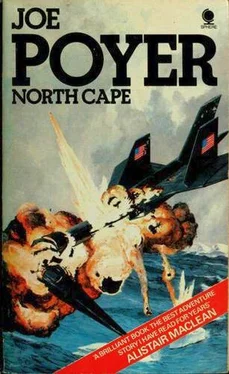Joe Poyer - North Cape
Здесь есть возможность читать онлайн «Joe Poyer - North Cape» весь текст электронной книги совершенно бесплатно (целиком полную версию без сокращений). В некоторых случаях можно слушать аудио, скачать через торрент в формате fb2 и присутствует краткое содержание. Город: London, Год выпуска: 1978, ISBN: 1978, Издательство: Sphere Books, Жанр: Триллер, на английском языке. Описание произведения, (предисловие) а так же отзывы посетителей доступны на портале библиотеки ЛибКат.
- Название:North Cape
- Автор:
- Издательство:Sphere Books
- Жанр:
- Год:1978
- Город:London
- ISBN:978-0-722-17006-9
- Рейтинг книги:4 / 5. Голосов: 1
-
Избранное:Добавить в избранное
- Отзывы:
-
Ваша оценка:
- 80
- 1
- 2
- 3
- 4
- 5
North Cape: краткое содержание, описание и аннотация
Предлагаем к чтению аннотацию, описание, краткое содержание или предисловие (зависит от того, что написал сам автор книги «North Cape»). Если вы не нашли необходимую информацию о книге — напишите в комментариях, мы постараемся отыскать её.
North Cape — читать онлайн бесплатно полную книгу (весь текст) целиком
Ниже представлен текст книги, разбитый по страницам. Система сохранения места последней прочитанной страницы, позволяет с удобством читать онлайн бесплатно книгу «North Cape», без необходимости каждый раз заново искать на чём Вы остановились. Поставьте закладку, и сможете в любой момент перейти на страницу, на которой закончили чтение.
Интервал:
Закладка:
As the A-17 came over the Irtysh River where it flowed down through a deep gorge cut through the foothills of the Altai Mountains, Teleman suddenly glimpsed a small patch of heat on the infrared screen some thirty miles west of the Kazakh border into Sinkiang. A feeling of elation coursed through him. The whole operation might turn out to be easier than he thought. Ending the coded message that Larkin had transmitted from the ship containing his countering orders was the message “Imperative you procure visual data of war situation.” He had to come back with actual photographs of the fighting for the mission to be successful. Without photos, the impact of the conflict between Red China and the Soviet Union would be lost on the world. The public would tend to interpret it as another smoke screen or propaganda play. The patch of heat detected by the infrared sensors could very well lead to those photographs. Teleman examined the IR screen carefully. There, in the.center of the blacked-out snowcovered rock and scrub-covered walls of the gorge that led toward the border was a barely discernible shade of gray, only slightly lighter than the surrounding valley. Teleman pulled around in a tight circle, concentrating visual sensors and cameras on the spot. He had earlier cut his speed from Mach 1.2 to sub-sonic when he had dropped below one hundred thousand feet to avoid sonic boom. Now he throttled back even more, running out the variable geometrical wings until they were extended to the fullest to hold his speed at two hundred knots.
The television cameras were displaying’ the deep valley and he carefully began cranking up the image until he could make out a two-wheel track twisting through the rock and paralleling a tiny stream. Shortly a military vehicle came into sight around and from under a shoulder-like overhanging rock. It moved slowly into the open and began to pick up speed along the track. A minute passed and a second vehicle appeared, and then a third.
Teleman brought the aircraft around on the opposite heading and slowed ” still further until the fan assemblies engaged and wound up to thirty thousand RPM to provide extra airflow over the wing surfaces to support the aircraft. He was now down to 105 knots. A check of the radar detectors showed nothing more than a routine search patrol nearly eighty miles south, probably Chinese. No scrambled Chinese fighters were recorded. He turned his full attention back to the vehicles again.
The trucks were now moving along the roadway at about forty-five miles an hour, pretty fast for military vehicles on an almost nonexistent road. He cranked the images up to their highest degree of magnification and identified them as Kirov five-ton troop lorries. Ahead of the trucks Teleman could see that the narrow gorge opened up and climbed steeply to a flattish plain that butted sharply against a series of rocky foothills. The foothills appeared to be their destination. -Now he could also see artillery pieces on limbers bouncing along behind each truck. As the trucks reached the spot where the valley began to widen, they had to pass through a narrow defile several hundred yards long. There was no place to turn off the road and, because it snaked through the gap, it would be all but impossible to back out with the artillery pieces. The Chinese must have been waiting for just that moment.
Artillery opened up from somewhere deep in the foothills. The first truck was lucky and ran the ranging gauntlet. Cannon shells, four of them, burst high on either side of the first truck. As it cleared the pass, it sped for the safety of the foothills less than half a mile away. The second truck was not so lucky. It was caught by a fifth artillery shell that arrowed down into the defile and exploded. The truck disintegrated in the explosion, the gas tank and ammunition going up in a fierce welter of flame. The third truck skidded to a halt only a short distance behind and was hit almost immediately. For three more minutes a heavy barrage of fire pursued the first truck, but it managed to reach the foothills below, to which the enemy artillery men obviously could not depress their guns. Teleman’s cameras faithfully recorded the action on tape. The entire sequence had taken less than two minutes, but two minutes was too long for Teleman to maintain such a low speed. Someone would be bound to notice. He increased power to bring the aircraft up to five hundred knots and forty thousand feet again as he broke out of the tight orbit and resumed his search along the border. The flight plan called for a shallow zigzag pattern along the border that would carry him fifty-odd miles into enemy territory on the first, high-altitude pass. The second pass would be modified by data from the nonvisual sensors and would concentrate on areas of heavy troop concentrations. One area particularly was read out by the flight-control complex. It indicated modifying data being received from one of the SAMOS series designated Advanced Reconnaissance 7. The satellite system had spotted an unusual degree of infrared activity twenty miles behind Chinese lines in the vicinity of Kuldja on the Ili River. The river flowed through a wide pass and crossed the border fifty miles east of the scrub town, important only as a staging point for whomever could hold it. At the moment it was in the hands of the Chinese.
Its principal danger lay in the fact that it commanded the shallow heights that led gradually to the border and the start of the Kazakh steppe, then out across the flat grasslands. The pass down which the Ili River flowed from the Tien Shan to Lake Balkhash was an arrow aimed directly at the huge Soviet military complex around the Kazakh city of Alma Alta.
The infrared patch that AR-4, satellite AR-7’s predecessor, had detected immediately caused its IR and visual light lenses to shift focus. At the optimum moment, recorders were activated and they picked up two images. In its brainless way AR-4 was excited by what it saw. The visual light cameras showed a cluster of trucks and, more important, a special variable called a 210-mm cannon mounted on a massive tracked crawler. As AR4 had watched, the cannon had spat a shell. The IR cameras saw the flash of fierce gases erupting from the muzzle and immediately the computer tripped a relay that caused the tape to spurt through the reel. The visual light cameras tracked the shell in free flight as the lenses shifted focus quickly to follow the trajectory.
In twelve seconds of flight the shell flew unerringly to detonation. There was no explosion worth mentioning, merely a spreading cloud, recorded by the IR cameras until it cooled and was lost in background scatter. Program 14 — designed to watch for nuclear weaponry — noted the disappointing blast and gave way to Program 1, GENERAL SURVEILLANCE.
Program a took its time digesting the data — all of three nanoseconds — then scanned rapidly across its disk memory to match this variable against any of eight billion bits of data. It found none. Program 1 reached the end of its rack and automatically tripped Program 99, code named OVERVIEW. Program 99 evaluated the data, found the flight pattern it needed, then instructed Program 1 to include the new datum in its general report. Five minutes later a coded message left AR-4 and was received by a picket ship south of Ceylon. By the time the message came to the attention of the project director on the night shift in Virginia, AR-4 was already eleven minutes away from the site deep in the Tien Shan and over East Pakistan. The task of relaying the instructions from Virginia plus the new information fell to AR-7, traveling a parallel track to AR-4, but 250 miles east and half an orbit behind.
Teleman studied the new data for several seconds, then punched the program tab that recorded the new flight plan segment, modifying the original, and fed it to Flight Control. Immediately, the, A-17 lifted for altitude, climbing swiftly on its turbofans to eight thousand feet. If warranted, he would return to complete the original low-level flight after checking out the threatening artillery piece. The 210-mm gun was one of the largest artillery pieces in the world. It was capable of throwing a three-thousand-pound shell a distance of forty-two miles. Originally, a similar artillery piece had been designed by the United States Army in 1953, as a nuclear cannon for tactical uses in the event of a war in Europe. The Soviets had immediately retaliated with their own version. But as short and intermediate-range ballistic missiles improved in size, accuracy, and transportability, the cumbersome gun had been discarded. Obviously the Soviets had discarded at least one of theirs to the Red Chinese, probably in the late 195os when everything, at least outwardly, was still sweetness and light between Russia and China. Now the Chinese appeared to be using the cannon against their one-time benefactors. But, as the instructions pointed out, they had not used a nuclear shell — or if they did, it had failed to explode. Teleman’s job was to verify the possibility that a nuclear shell might have failed or else find out what they were shooting that required such an effort and such a large caliber weapon. “Great,” he muttered aloud. Ten minutes later Teleman passed over the muddy city of Kuldja and the frozen Ili River. He turned inland for a brief moment to bring the aircraft to the head of the pass, and then swung into a tight sub-sonic orbit again. A ground control map flew across the scope matching his ground speed. At the proper moment Teleman began the long, twenty-five-mile swing onto a — heading of 353° N and bent to check the surveillance radar. The screen was blank except for scattered blips above him, indicating the presence of high ice-cloud formations. Interested, he shifted to Weather Surveillance and asked for a readout on the ice cover. The panel indicated that it was building quickly to a solid cover above 175,000 feet and gradually extending eastward to cover all of Central Asia. At the moment, it was solid — solid that is to radar, but invisible to the eye — between the Kirghiz SSR — Tadzhik SSR border to the south and the Urals to the east. He instructed Weather Surveillance to continue monitoring the cover and flipped back to the surveillance radar. Teleman then cranked the image outward, extending it to its full 1600-mile diameter. There on the western quadrant, four blips were rising, probably from the base at Alma Alta. The interceptors were well inside the Soviet border and did not appear too interested in anything other than patrolling for Chinese aircraft. They were down on the deck at less than ten thousand feet. East, there was little activity except for what appeared to be cargo aircraft on the Chinese side. He spotted a long line of heavy-cargo planes, escorted by fighters, coming in from China proper. Teleman checked once more on the four Soviet interceptors, watching for a long moment as they completed the formation and turned north and east. They appeared to be flying sub-sonic-as a border patrol would. But if they turned east still further and crossed the border, they would bear watching. To be on the safe side he fed data to the computer and ordered it to keep tracking. Then he turned his attention back to the ground control map.
Читать дальшеИнтервал:
Закладка:
Похожие книги на «North Cape»
Представляем Вашему вниманию похожие книги на «North Cape» списком для выбора. Мы отобрали схожую по названию и смыслу литературу в надежде предоставить читателям больше вариантов отыскать новые, интересные, ещё непрочитанные произведения.
Обсуждение, отзывы о книге «North Cape» и просто собственные мнения читателей. Оставьте ваши комментарии, напишите, что Вы думаете о произведении, его смысле или главных героях. Укажите что конкретно понравилось, а что нет, и почему Вы так считаете.












